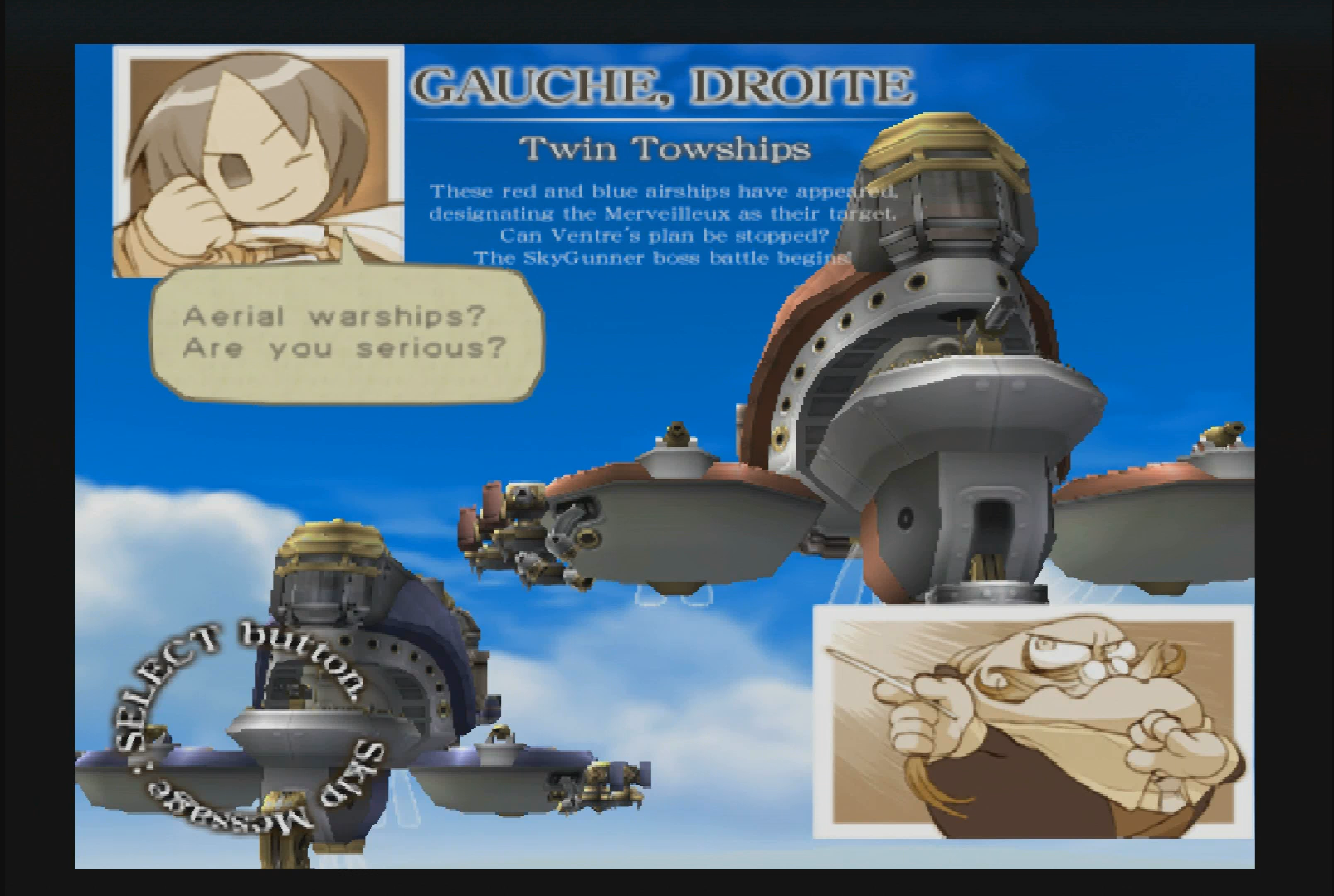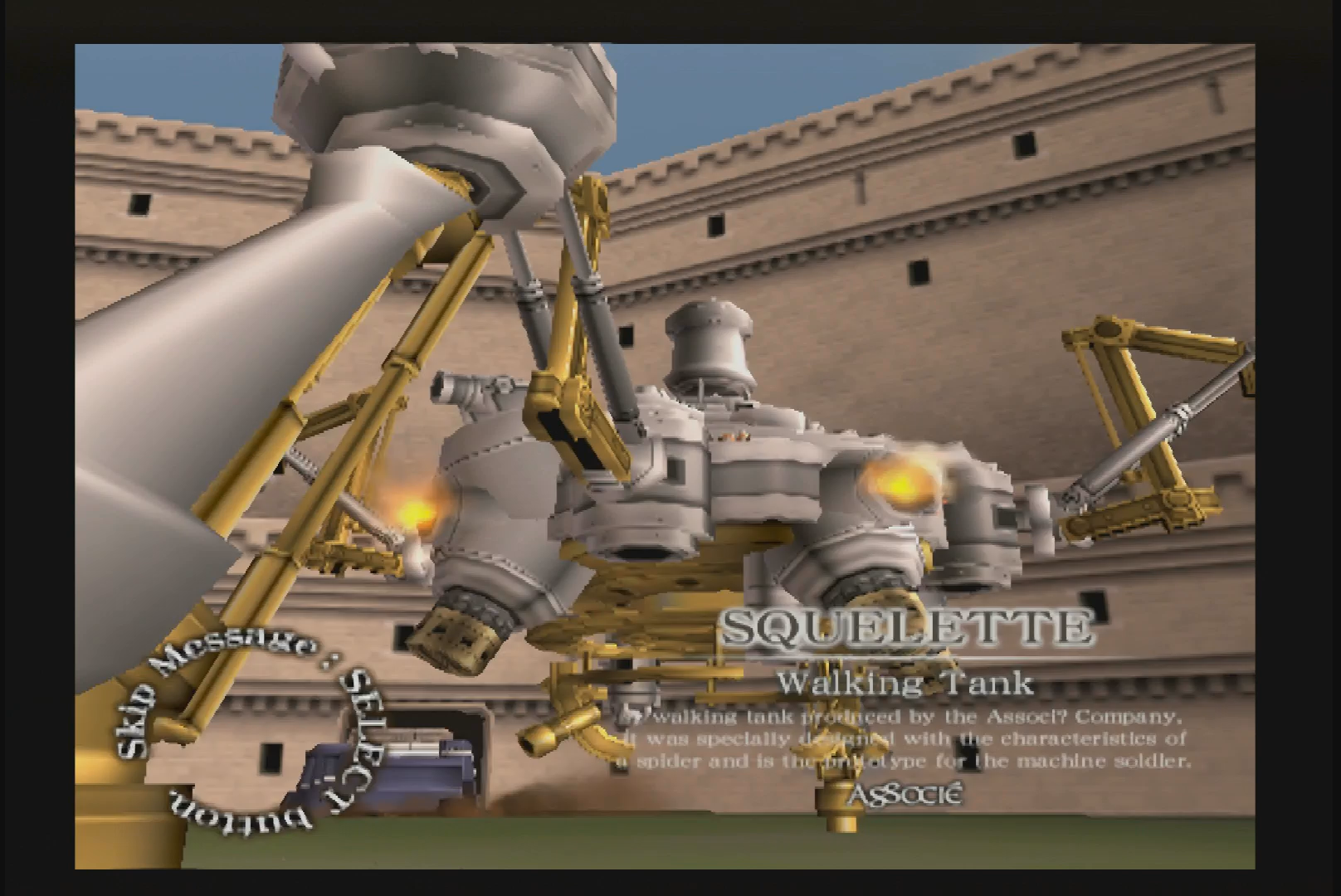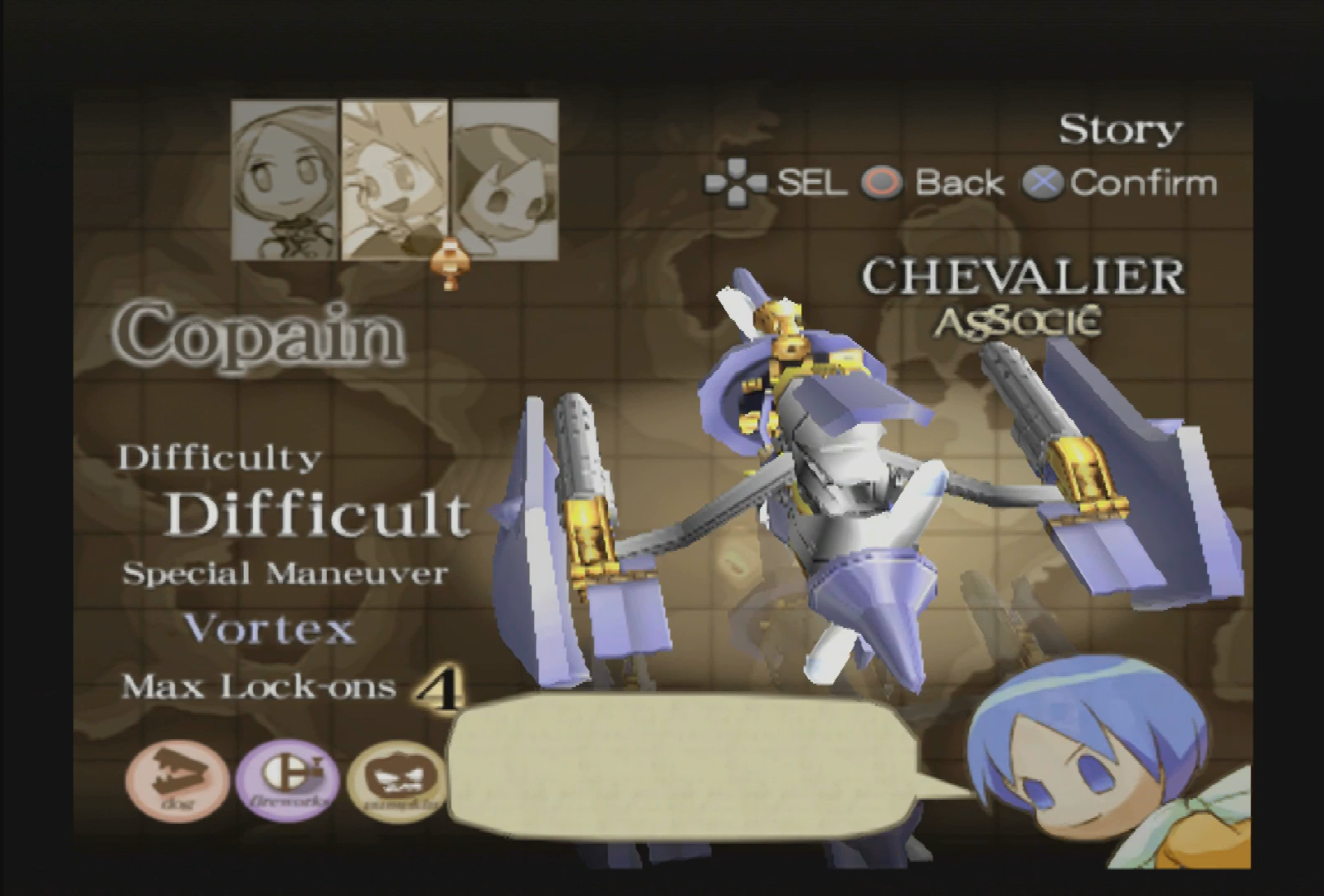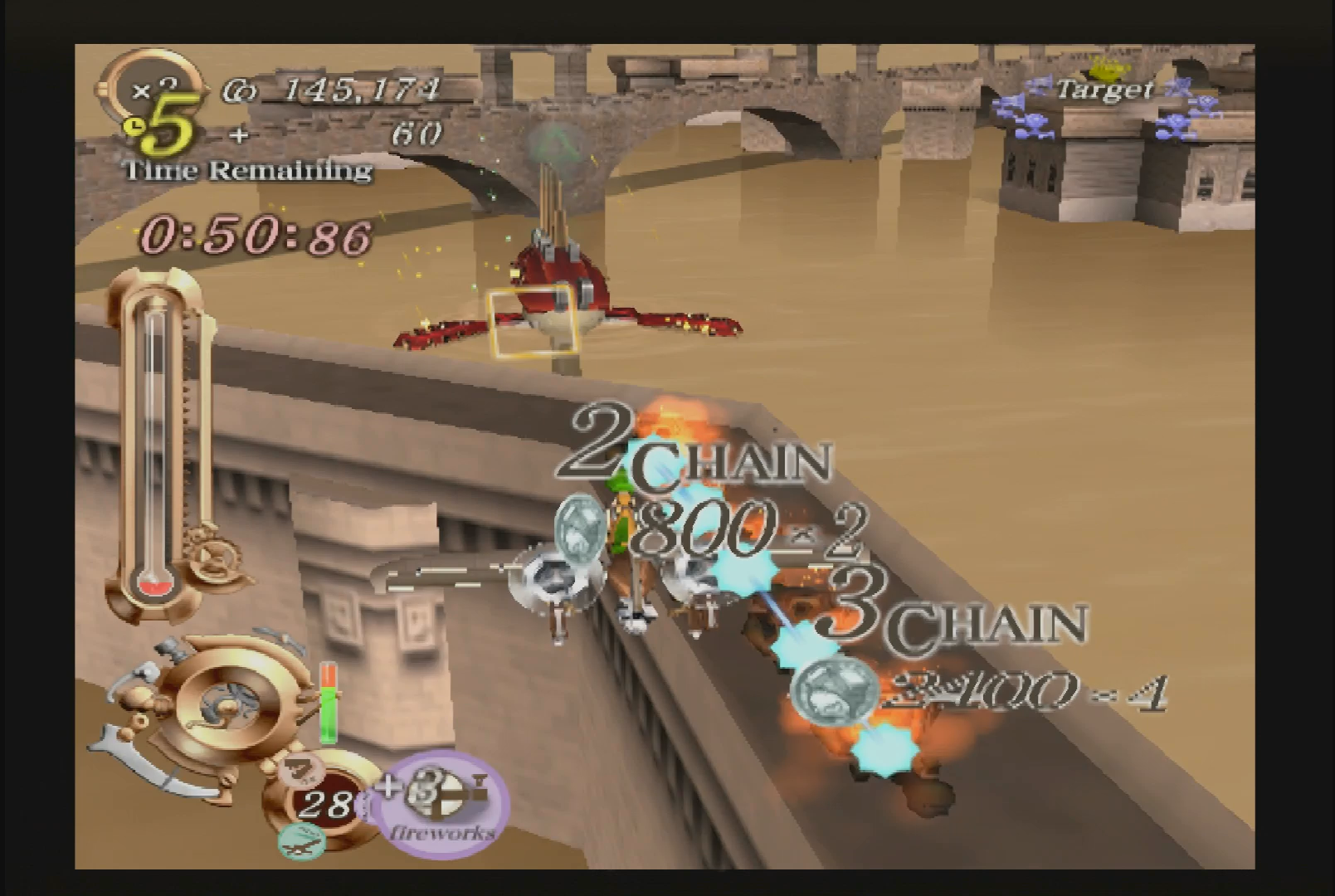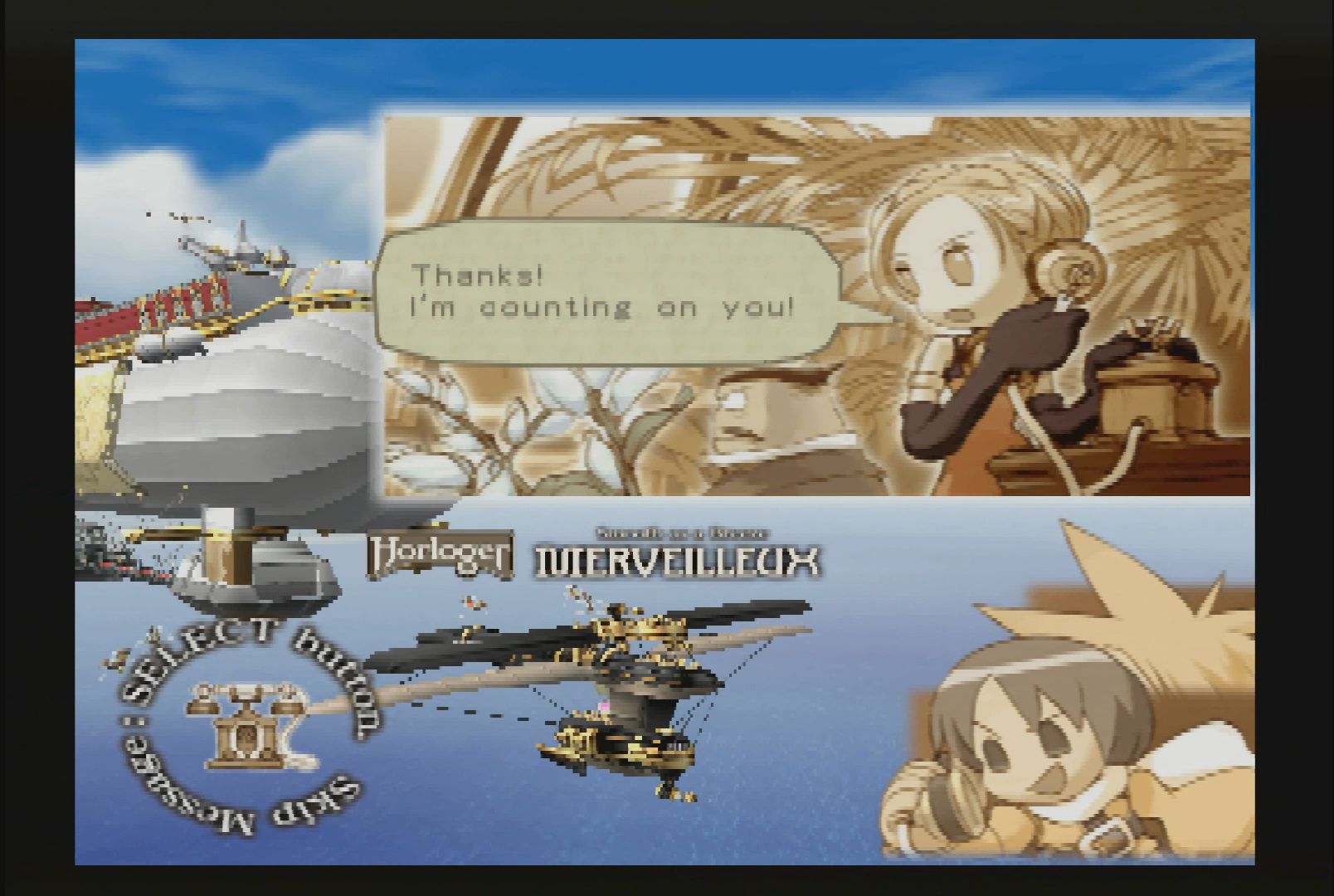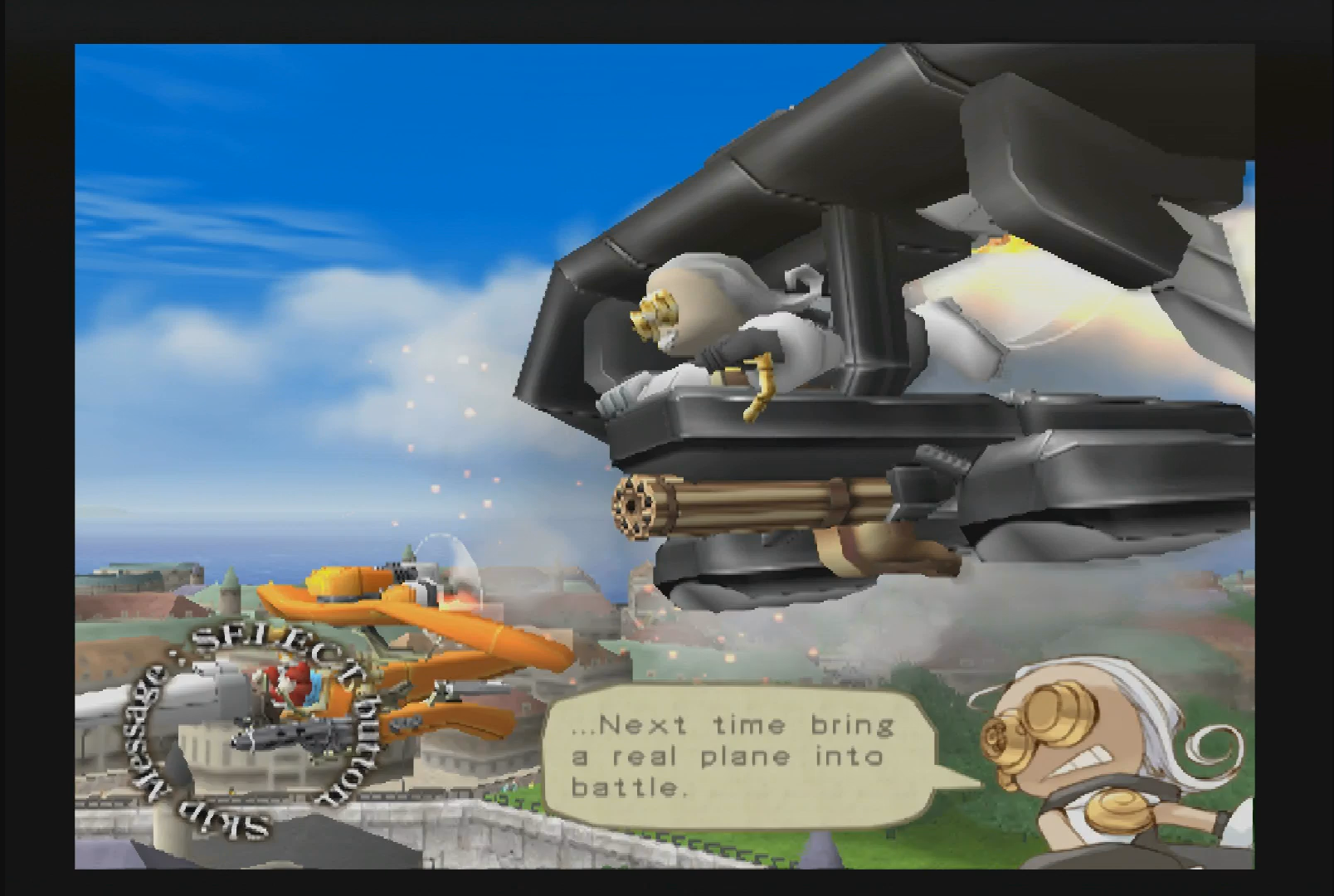 SkyGunner
SkyGunner
Playstation 2, 2002
Developer: Pixel Arts
Publisher: Atlus
In 2002 I worked as a writer for a moderately trafficked game review site, ps2insider.com. I found this position by dropping “video game writer jobs” into AltaVista. The job consisted of reaching out to the PR departments of game companies, bragging about our site analytics, and more or less begging them to send us material to cover. This position did not pay, but I got to keep any materials that I could convince publishers to send to me. Below is an annotated copy of my review for SkyGunner, originally posted on June 24, 2002. SkyGunner was not the first game I reviewed, but it is the first one I received for free, so it holds a special place in my heart. Enjoy!
While the folks at Atlus have placed Skygunner in the genre of “Aerial Adventure,” don’t let that moniker fool you. Despite its cartoonish appearance and ever-so-cute big-eyed anime cast, Skygunner is a shooter fan’s shooter, with an emphasis on high scoring and slick maneuvering.
[2020 – For whatever reason, I did not intercap the title in my original review. We basically had no editorial oversight, so if you uploaded something with errors, it stayed that way. I later learned my “editor” was an 18-year-old Australian kid. Nowadays, you would never refer to SkyGunner as a “shooter;” back in 2002 “shooter” didn’t immediately suggest “first person shooter.” It would be more appropriate to call it a “third person aerial combat” game.]
Playing like the rebel lovechild of Panzer Dragoon and Starfox 64, Skygunner is a 3D scoring extravaganza that just begs to be mastered.
[2020 – Though corny and overwrought, this description is apt. This was a total nerd flex: at the time, name dropping an under-appreciated Saturn game like Panzer Dragoon was a way to let other nerds know you were legit.]
Taking place over a bizarre 1930s French backdrop, Skygunner chronicles the adventures of a group of hired airborne mercenaries, Femme, Ciel, and Copain.
[2020 – It’s steampunk. Just look at that thing. I just didn’t know what steampunk was. To be fair, I don’t know if anybody other than steampunks knew what steampunk was in 2002.]
Hired to defend an Expo on the island town of Rive, the gunners run into trouble when Ventre, an unusually well armed criminal genius, sets his sites on grabbing some of the Expo’s more notable exhibits to power his fleet of battleships. The story unfurls through exquisitely drawn anime-style cutscenes between each level and mission objective, all of which are accompanied by excellent voice acting, available in both its original Japanese and English varieties. While it plays second fiddle to all the airborne action, Skygunner’s story is excellently produced.
[2020 – “Exquisite” was definitely bit much, but the unique art style really pops, particularly when upscaled.]
Each character (There are five total, two of which are immediately playable) has his own aircraft, with its own set of capabilities and mission objectives to accomplish. Every vehicle offers a uniquely different playing style, and there are plenty of unlockable modes and goodies to get your hands on, so replay value for Skygunner is high, right from the get-go. Learning the nuances of each gunner’s aircraft alone is entertaining enough to keep you practicing for hours.
[2020 – This is actually tough for me to read; I’m being overly effusive because someone sent me a free game. I still have my original save: when I started this project, my play clock was at about 5 hours. I clearly did not practice this game for “hours.” SkyGunner is at times enjoyable, but it is, at best, an average game. Even at the time, I think I knew I was over-accentuating the positive. Unless you were a huge site like IGN, there was a fear that you’d get cut off if you posted a bad review.]
There are two options for controlling your fighter, and they are appropriately dubbed “simple” and “advanced.” The difference between the two is quite drastic. Simple, the default setting, leaves movement to the left analog stick and d-pad, while advanced requires the use of the whole controller, allowing for some fancy, but extremely tricky maneuvers. These control schemes are accompanied by two methods of targeting, one allowing only targeting of primary enemies, and another which lets you have your pick of any target on the field, right down to the smallest cannon on the tiniest destroyer. Controlling your fighter is as easy or as difficult as you need it to be.
[2020 – The controls are hot trash, but I was probably too “scared” to say that. “Simple” is manageable but gimped; it basically prevents you from barrel rolling. “Advanced” allows you to freely roll your fighter with an overly sensitive analog stick, and maps turning to two shoulder buttons. One wonders why rolling wasn’t mapped to the shoulder buttons (like in Starfox). I have a theory that the game was designed around the “advanced” controls, but the designers realized that they were too cumbersome late in the process.]
What drives the combat in Skygunner is the game’s intricate scoring system, which stresses quickness and efficiency. Large scores are earned by destroying large groups of enemies at once or setting off chains of explosions. The faster these explosions come, the greater the score multiplier becomes, allowing for some truly astronomical bonuses. Points are deducted when damage is taken and when weapons are wasted. The end result is a fierce battle for bonuses as you fight against not only your enemies, but also your wingmen as you try to outscore them to unlock more secrets and better fighters. It makes for a white-knuckle gaming experience that will keep the dedicated player glued to his controller.
[2020 – “Intricate” was a bad choice. The scoring system is really no more complex than what I described above. That being said, it is, in fact, there: if you are the type of person that enjoys maxing out your scores, SkyGunner give you a somewhat engaging framework in which to do that. The rewards are minimal though; just two extra modes. As a 20-year-old, I might have invested some time into mastering the scoring system. As an adult, it ‘s almost laughable to suggest that anybody with actual responsibilities “practice” this game to get better at it.]
An intricate scoring system, simple, customizable controls, and a beautiful sense of style and presentation – Skygunner has it all, right? Alas, I wish that were true. The game suffers from some crucial flaws that prevent it from being a true classic. First and foremost are the game’s camera problems. Skygunner uses a dynamic camera system that keeps the camera on your vehicle and its current target at all times. Most of the time, this creates some beautiful visual effects as you get to see the full visual splendor of your fighter as it swoops across the screen to attack. However, what the camera does not account for are any walls, obstacles, or vehicles that might appear between you and your target. Chasing down an enemy gunner and getting interrupted by that wall that you couldn’t see two seconds ago can prove frustrating. This also makes it rather difficult to choose a specific target at times, when you need to target something the camera just won’t pan around to let you see. More often than not, you’re left using the auto-targeting to cycle through all of the available targets to find the one you’re looking for, which is quite difficult when you’re getting blasted out of the sky.
[2020 – The camera is really the crux of the game’s problems. The camera has two settings: (1) always on your butt (useless) and (2) constantly doing whatever it needs to do to keep you and your current target in frame. It is extremely difficult to keep track of your surroundings and, at times, know which way your ship is facing. To make matters worse, you can target obstructed objects – you’ll switch targets to a massive battleship and open fire for a good 10 seconds only to find that the camera was trained on some weak point on the opposite side of the ship. The camera does have a knack for producing some gripping action shots, though. SkyGunner is a beautiful game to watch, but a frustrating game to play.]
Graphically, Skygunner is a mixed bag – while landscapes appear to lack detail, it’s only to accommodate for the truly massive number of wonderfully designed vehicles on screen, including some truly massive battleships, all lit up by the glow of exploding missiles and setting suns. Skygunner’s battles are truly epic in proportion, and beautiful in their design. Unfortunately, sometimes the game’s engine gets overloaded with visual effects, and the action tends to slow to a crawl when you least need it to, when the screen is full of enemies firing off explosive rounds. However, the folks at Atlus were kind enough to include a mode which lets you toggle the processing speed between a variable 60fps, or a less visually spectacular, but uniform, 30fps with little or no slowdown. This mode can be unlocked through completing the game, or by entering a code on the title screen, which Atlus has provided us: Up, Triangle, Left, Circle, Down, X, Right, Square.
[2002 – To my recollection, this is the first time I had ever heard of (let alone written about) console game performance in terms of “frames per second.” SkyGunner has two display modes: (1) a default 480i mode that targets 60 fps but fails horribly any time the action gets intense; and (2) a 240p mode that looks demonstrably worse, but (mostly) stays locked at 30 fps. What is strange, though, is that this is not a freely selectable option; it’s an unlockable. Despite this, Atlus USA recognized the game’s flaws, and asked the American gaming press to publish a cheat code to unlock this option (you can see this in the press kit images below). This is like some strange early version of a day 1 patch. Looking back, this is the most fascinating thing about both this review and this game.]
In short, Skygunner is a great shooter occasionally hampered down by a couple of extremely frustrating technical problem. If you’re willing to deal with the game’s technical shortcomings, Skygunner offers just the kind of incredibly fun, intense dogfighting action that the console world has desperately needed for some time. Despite its flaws, Skygunner is still a fine example of a 3D shooter, and an enjoyable one to boot.
Presentation- 9.0 / Gameplay- 9.0 / Graphics- 7.0 / Sound- 8.0 / Replay Value- 8.0 / Originality- 7.0 / Overall- 8.0
[2020 – I clearly was grading on a 6-10 scale here. If I were to rework my scores today, they would look as follows: Presentation- 7.0 / Gameplay- 6.0 / Graphics- 6.5 / Sound- 6.0 / Replay Value- 5.0 / Originality- 7.0 / Overall- 6.0]
The gallery below contains scans of the press kit I received from Atlus:
Here are the “bullshots” from Atlus. There was no way the game was ever going to look this nice on your tube TV in 2002:
And here’s what I could salvage of the original site:
I hope you enjoyed this trip down memory lane! I may do a SkyGunner video soon – but I am finding it difficult to will myself to play the game. Even in a quarantine.


